
Eudonia philerga is a species of moth of the family Crambidae. This species was first described by Edward Meyrick. It is endemic to New Zealand and is found throughout the country. E. philerga is regarded as being common. Larvae feed on moss and the adults have been observed on the wing more frequently from October to April. Adult moths are attracted to light.

Mnesarchaea paracosma is a species of primitive moths in the family Mnesarchaeidae. It is endemic to New Zealand and can be found in the Kaikōura, mid and south Canterbury, MacKenzie, Otago Lakes, Central Otago, Dunedin, Fiordland and Southland areas. M. paracosma lives in a wide variety of habitats including tussock grasslands, shrubland, and damp native beech or podocarp forests, at a range of altitudes from around sea-level up to 1200 m. Adults of this species are on the wing from October to February and are day flying, although they are attracted to light at night.
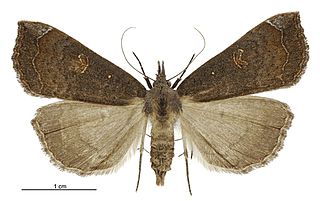
Rhapsa scotosialis, the slender owlet moth, is a moth of the family Noctuidae. This species is endemic to New Zealand and is found throughout the country. It is regarded as one of the most common forest moths found in New Zealand. The larval host species for R. scotosialis is Piper excelsum.

Pseudocoremia lutea is a species of moth in the family Geometridae. It is endemic to New Zealand. It is classified as "At Risk, Naturally Uncommon" by the Department of Conservation.
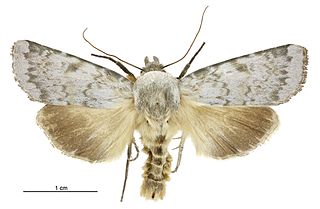
Physetica caerulea is a species of moth of the family Noctuidae. It is endemic to New Zealand and can be found from the centre of the North Island south, including the South and Stewart Islands. The adult moths are variable in appearance but can be distinguished by the bluish tinge to the forewings as well as the underside buff colour. However this species does have several forms including a very dark bluish black form, a brownish form and a green-brown form. It lives in open habitats and can be found in tussock grasslands and dunes and can normally be found from altitudes of sea level up to 900 m. Adults of this species are on the wing from August to April. As at 2017, the life history of is unknown as are the host species of its larvae. However it has been hypothesised that the larval host species is a tomentose plant.

Dasyuris partheniata is a species of moth in the family Geometridae. It is endemic to New Zealand. It is classified as "At Risk, Declining" by the Department of Conservation.

Asaphodes glaciata is a species of moth in the family Geometridae. This species is endemic to New Zealand. This moth has only be found in Westland in the areas near Fox and Franz Josef Glaciers. Adults of this species are on the wing in January.

Tingena compsogramma is a species of moth in the family Oecophoridae. It is endemic to New Zealand and has been observed in the North and South Islands. This species inhabits native forest and adults are on the win from December until March.

Tingena pharmactis is a species of moth in the family Oecophoridae. It is endemic to New Zealand and has been observed in the Nelson, Tasman and Wellington regions. The adults of this species are on the wing in December.

Tingena xanthodesma is a species of moth in the family Oecophoridae. It is endemic to New Zealand and has been observed in Southland, the Otago region, and on Kapiti Island. This species inhabits native forest and is on the wing from November to February.
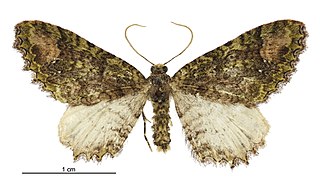
Austrocidaria venustatis is a species of moth of the family Geometridae. It endemic to New Zealand and has been collected in Southland. Adults of this species are on the wing in December.

Meterana alcyone is a species of moth in the family Noctuidae, the owlet moths. This species is endemic to New Zealand and is found in the North and South Islands. The larvae of this species feed on the leaves of Muehlenbeckia complexa and Corynocarpus laevigatus. Adults are on the wing every month of the year except January. They are attracted to light and have also been recorded as bycatch in the New Zealand National Fruit Fly Surveillance fly traps.

Meterana asterope is a species of moth in the family Noctuidae. This species is endemic to New Zealand and is found in the North and South Islands. It inhabits both native forest and open habitat and adults emerge during the New Zealand summer. Adults are on the wing in December and January. This species is attracted to light and has also been collected via sugar traps.

Dasyuris fulminea is a species of moth in the family Geometridae. It was first described by Alfred Philpott and is endemic to New Zealand. It has been observed in the regions of the West Coast, Fiordland and Otago. Adults are day flying and are on the wing from December until February.
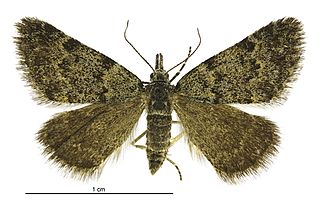
Dichromodes cynica is a moth of the family Geometridae. It was first described by Edward Meyrick in 1911. D. cynica is endemic to New Zealand and is found only around Christchurch and Banks Peninsular. The larvae of D. cynica are cryptic in appearance and feed on lichens growing on dry sunny rock faces. Adults are on the wing from September to February. D. cynica are active during the day and are rapid fliers.

Dichromodes ida is a moth of the family Geometridae. This species was first described by George Hudson in 1905. It is endemic to New Zealand and is found in Central Otago. This species inhabits open rocky places at altitudes between 100m to 900m. The larvae of D. ida are cryptic in appearance and feed on lichens growing on rocks. They appear to pupate in rock clefts, forming a chamber made of moss and silk. Adults are day flying and are on the wing from October until December.
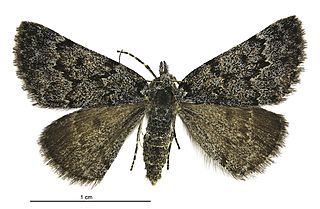
Dichromodes niger is a moth of the family Geometridae. It was described by Arthur Gardiner Butler in 1877. This species is endemic to New Zealand and can be found in the lower part of the South Island and upper half of the North Island. It inhabits rocky sites or forest clearings. The larvae feed on lichen. Adults are day flying, are rapid fliers, and are on the wing from November until January.

Xanthorhoe occulta is a species of moth in the family Geometridae. It is endemic to New Zealand and was first described by Alfred Philpott in 1903. It is found in the North, South and Stewart Islands. The adult moths are on the wing from
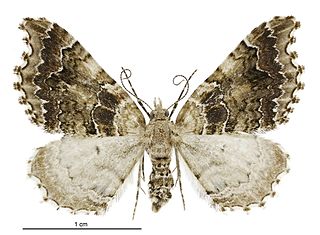
Helastia cymozeucta is a moth of the family Geometridae. It was first described by Edward Meyrick in 1913. This species is endemic to New Zealand and is found in both the North and the upper parts of the South Island. The adults of this species have been observed on the wing from November to January as well as in March.

Xanthorhoe orophylloides is a moth of the family Geometridae. It was first described by George Hudson in 1909 and is endemic to New Zealand. This species is found in the subantarctic islands including at the Auckland Islands and at Campbell Island.






















